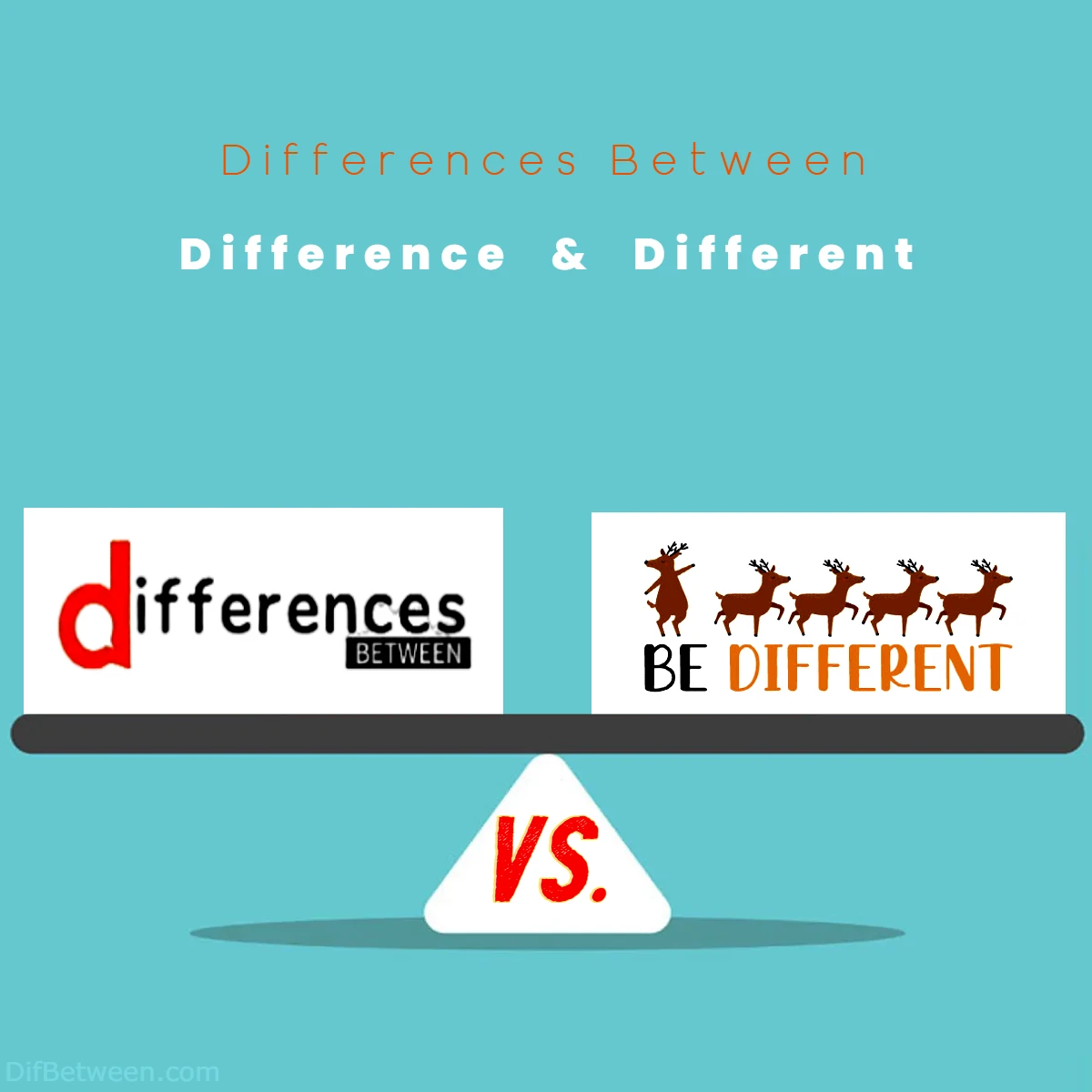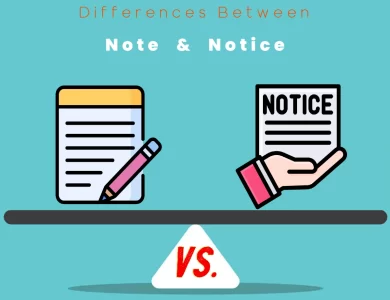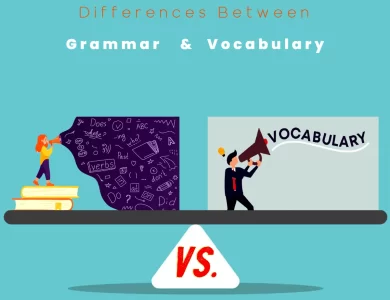
| Aspect | “Difference” | “Different” |
|---|---|---|
| Part of Speech | Noun | Adjective |
| Definition | Signifies distinctions or disparities between things | Describes something as not the same, distinct, or unique |
| Usage in a Sentence | – The difference in price is significant. | – I enjoy trying foods from different cultures. |
| Countable/Uncountable | Typically used in a countable sense; can be pluralized | Often used in an uncountable sense; not typically pluralized |
| Comparative Language | Frequently used to highlight variations between two or more things | Often used when comparing multiple items to emphasize their uniqueness |
| Abstract Concepts | Used to represent distinctions in abstract concepts like opinions or perspectives | Applied to abstract ideas to emphasize their distinctness |
| Common Mistakes | Using “difference” when an adjective is needed | Using “different” as a noun when a noun is required |
| Synonyms | Distinction, Discrepancy, Variation, Disparity, Divergence | Distinct, Diverse, Varied, Unique, Dissimilar |
| Antonyms | Similarity, Sameness, Resemblance, Identity, Homogeneity | Alike, Similar, Uniform, Identical, Homogeneous |
In this linguistic adventure, we’ll not only demystify the grammatical nuances but also provide you with practical insights to enhance your command of these words. Whether you’re a seasoned wordsmith or just beginning your linguistic voyage, this exploration will equip you with the tools to choose the right word at the right time.
Differences Between Difference and Different
The main differences between “difference” and “different” lie in their grammatical roles and usage. “Difference” is a noun that signifies distinctions or variations between objects or concepts and can be countable or uncountable. On the other hand, “different” is an adjective that describes how something is distinct or unique compared to others. It’s important to choose “difference” when you need a noun to highlight distinctions, while “different” is the go-to word when you want to describe the uniqueness or diversity of something. Understanding these nuances empowers you to use these words effectively in your communication.
Definition and Usage
Difference:
The word “difference” is primarily a noun that refers to the state or quality of being dissimilar or distinct from something else. It signifies the variation, contrast, or dissimilarity between two or more things. When you want to highlight the contrast or variation between objects, concepts, or ideas, “difference” is your go-to word.
Here’s an example of how “difference” is used in a sentence:
- There is a significant difference between traditional education and online learning methods.
Different:
“Different,” on the other hand, is an adjective that describes something that is not the same as another or stands apart in character, quality, or nature. It is used to emphasize individuality or distinctiveness.
Here’s an example of how “different” is used in a sentence:
- Each member of the team has a different approach to problem-solving.
Now, let’s delve deeper into these words to uncover their nuances and unique applications.
“Difference” in Depth
The noun “difference” is a versatile word that can be employed in various contexts to highlight distinctions or variations. It often serves as a pivot point for discussions, comparisons, and contrasts. Let’s explore its nuances further:
Quantitative Differences
“Difference” can be used to quantify variations between numerical values. In this context, it answers the question of “how much” one thing differs from another.
For example:
- The difference in their ages is five years.
Qualitative Differences
Beyond numbers, “difference” can also signify qualitative distinctions. It helps convey disparities in characteristics, attributes, or qualities.
For example:
- There is a marked difference in the taste between these two types of chocolates.
Comparative Usage
“Difference” is often used when making comparisons between two or more entities. It’s a crucial element in comparative analysis.
For example:
- Let’s discuss the differences between classical and operant conditioning in psychology.
“Different” in Depth
As an adjective, “different” carries the weight of distinctiveness and individuality. It’s a word that empowers you to describe the uniqueness of something. Here’s a closer look:
Qualitative Distinction
“Different” emphasizes the qualitative aspect of dissimilarity. It’s about highlighting how one thing is unlike another in character, nature, or quality.
For example:
- The two paintings are different in style and technique.
Individuality
When you want to stress the individual characteristics of items within a group, “different” comes into play. It celebrates diversity within a category.
For example:
- Each flower in the garden has a different color.
Personal Preferences
“Different” can also be used to express personal preferences or choices when it comes to liking or selecting one thing over another.
For example:
- I prefer a different flavor of ice cream every time I visit the shop.
Grammar and Usage Considerations
Understanding the grammatical nuances of “difference” and “different” is essential for using them correctly in your writing and speech. Here’s a closer look at their grammatical aspects:
Grammar of “Difference”
- Part of Speech: Noun
- Plural Form: “Differences”
- Usage in Sentences:
- The differences between the two cars are evident.
- Can you point out the key differences in their arguments?
- Common Phrases:
- “Make a difference”: To have a meaningful impact.
- “Spot the difference”: A puzzle or game involving identifying distinctions between two similar images.
Grammar of “Different”
- Part of Speech: Adjective
- Comparative Form: “More different” (used for comparisons)
- Superlative Form: “Most different” (used for the highest degree of difference)
- Usage in Sentences:
- She chose a different approach to solving the problem.
- This restaurant offers a different menu from the one we visited last week.
- Common Phrases:
- “Different strokes for different folks”: Expresses the idea that people have diverse preferences and needs.
- “Different ballgame”: Refers to a completely different situation or set of circumstances.
Examples of Correct Usage
Let’s explore some practical examples of how “difference” and “different” can be correctly used in sentences:
Examples of “Difference”
- There’s a noticeable difference in the texture between silk and cotton.
- Can you explain the difference between empathy and sympathy?
- The differences in their opinions led to a heated debate.
- Learning a new language can make a significant difference in your career prospects.
- The difference in temperature between night and day in the desert can be extreme.
Examples of “Different”
- Each snowflake is different from the others, forming unique patterns.
- The two siblings have completely different personalities.
- I appreciate how you have a different perspective on this matter.
- The cultures of Japan and Brazil are vastly different from each other.
- She tried on several dresses, but the last one felt different and perfect.
Common Mistakes to Avoid
To become a master of language, it’s essential to steer clear of common pitfalls. Here are some mistakes to watch out for when using “difference” and “different”:
Common Mistake 1: Using “Different” as a Noun
Incorrect: The different between the two cars is evident.
Correct: The difference between the two cars is evident.
Explanation: “Different” is an adjective and cannot serve as a noun on its own. You need “difference” to refer to the contrast between the two cars.
Common Mistake 2: Using “Difference” as an Adjective
Incorrect: These two paintings are very difference.
Correct: These two paintings are very different.
Explanation: “Difference” is a noun; “different” is the adjective you need to describe the paintings.
Common Mistake 3: Confusing “Different” with “Differently”
Incorrect: She solved the problem in a completely different manner.
Correct: She solved the problem in a completely differently.
Explanation: “Differently” is the adverb form of “different” and should be used to modify verbs, not “different” itself.
A Visual Comparison
To further illustrate the contrast between “difference” and “different,” let’s use a visual comparison in the form of a table:
| Aspect | “Difference” | “Different” |
|---|---|---|
| Part of Speech | Noun | Adjective |
| Plural Form | “Differences” | N/A |
| Comparative Form | N/A | “More different” (for comparisons) |
| Superlative Form | N/A | “Most different” (for the highest degree) |
| Examples | The differences in opinions led to conflict. | Each snowflake is different. |
| Usage | To express contrast or variation between things. | To describe distinctiveness or uniqueness. |
Practical Tips for Using “Difference” and “Different” Effectively
Now that we’ve thoroughly explored the differences between “difference” and “different,” it’s time to offer some practical tips on how to use them effectively in your writing and communication.
Context Matters
Understanding the context in which you are using these words is crucial. Ask yourself whether you are describing a contrast between things (use “difference”) or emphasizing the distinctiveness of something (use “different”). Consider the message you want to convey and choose the word that aligns with your intention.
Example:
- Context: Comparing two job offers.
- Correct Usage: The difference in salary between the two positions is substantial.
- Explanation: Here, we are highlighting the contrast in salary, so “difference” is the appropriate choice.
Use “Difference” for Comparisons and Analysis
When you are engaged in comparative discussions or analytical writing, “difference” is your ally. It allows you to dissect and examine distinctions between multiple items, concepts, or ideas.
Example:
- The differences between the three theories became evident as we delved deeper into their principles.
“Different” Emphasizes Uniqueness
“Different” serves as a flagbearer of uniqueness. Whenever you want to emphasize that something stands out or possesses individual characteristics, opt for “different.”
Example:
- Her taste in music is incredibly different from that of her friends.
Watch for Idiomatic Phrases
Both “difference” and “different” are integral to various idiomatic expressions in the English language. Familiarize yourself with these phrases to use them appropriately:
- “Make a difference”: This phrase signifies having a positive impact or influence on a situation or outcome.
- Example: Volunteering can truly make a difference in the lives of those in need.
- “Different strokes for different folks”: It expresses the idea that people have diverse preferences and needs.
- Example: We all have our unique tastes; it’s a case of different strokes for different folks.
Proofread and Edit Carefully
Whether you are writing an academic paper, a business report, or a creative piece, always proofread and edit your work. Pay special attention to instances where you’ve used “difference” or “different” to ensure they fit the context and convey your intended meaning accurately.
Advanced Usage Scenarios
Now that we’ve covered the fundamental differences between “difference” and “different” along with practical tips, let’s explore some advanced usage scenarios and examples that will further solidify your understanding of these words.
“Difference” in Technical and Scientific Contexts
In technical and scientific writing, “difference” plays a crucial role in conveying precise information. It is often used to describe variations and distinctions that require accuracy and specificity.
Example 1:
- The difference in voltage between the two terminals must not exceed 5 volts.
In this context, “difference” is used to indicate the exact numerical variation in voltage that is acceptable.
Example 2:
- Researchers observed a significant difference in the growth rates of the two plant species under different light conditions.
Here, “difference” is used to emphasize the measurable variations in growth rates between the plant species.
“Different” in Creative Writing and Expressive Language
In creative writing, poetry, or when you aim to add depth and nuance to your language, “different” can be a powerful tool. It allows for more expressive and subjective descriptions.
Example 1:
- The sunset over the ocean painted the sky with a palette of colors I had never seen before—a truly different world.
In this poetic description, “different” conveys a sense of wonder and uniqueness that goes beyond a mere factual statement.
Example 2:
- His approach to art was refreshingly different, challenging convention and inviting viewers to question their perceptions.
Here, “different” is used to celebrate the artist’s unconventional and innovative approach.
“Difference” and “Different” in Philosophical Discourse
In philosophical discussions and debates, both “difference” and “different” can be employed to explore abstract concepts and ideas.
Example 1:
- Philosophers have long debated the differences between ethics and morality, delving into the nuances of these concepts.
In philosophical contexts, “difference” helps dissect and analyze abstract ideas with precision.
Example 2:
- Existentialist thinkers often celebrate the individual’s capacity to create a different and authentic existence in a world filled with external influences.
Here, “different” emphasizes the existentialist notion of individuality and uniqueness in one’s life choices.
Conclusion
In the grand tapestry of language, “difference” and “different” are threads that add depth and richness to our expressions. While they may seem interchangeable at times, their roles and grammatical functions set them apart. “Difference” stands as a noun, a symbol of variation, while “different” adorns objects, ideas, and experiences with the cloak of uniqueness.
By mastering the nuances of these words, you’ll be better equipped to communicate your thoughts, ideas, and observations with precision and eloquence. So, the next time you spot a difference or encounter something different, you can appreciate the subtle distinctions that make our language so vibrant and diverse.
FAQs
The fundamental difference lies in their grammatical roles and meanings. “Difference” is a noun used to highlight distinctions or variations between objects or concepts, while “different” is an adjective that describes how something is distinct or unique compared to others.
While they may seem similar, “difference” and “different” serve different linguistic purposes. “Difference” is used when emphasizing distinctions or disparities, while “different” is employed to describe the uniqueness or diversity of something. Using them interchangeably can lead to confusion.
To decide, consider whether you need a noun or an adjective in your sentence. If you’re highlighting distinctions or disparities, opt for “difference.” If you want to describe the distinctness or uniqueness of something, choose “different.”
One common mistake is using “difference” as an adjective when you need an adjective, and vice versa with “different.” Additionally, ensure subject-verb agreement when using “difference” in its plural form.
Certainly! “Difference” can be used in sentences like “The difference in temperature between seasons is noticeable,” while “different” can be used in sentences like “These two books have different genres.”
Yes, there are synonyms for both. Synonyms for “difference” include “distinction,” “discrepancy,” and “variation.” For “different,” synonyms include “distinct,” “diverse,” and “unique.”
Indeed, antonyms for “difference” include “similarity,” “sameness,” and “identity.” For “different,” antonyms include “alike,” “similar,” and “identical.”
Understanding their distinctions can help you express yourself clearly. Use “difference” when emphasizing distinctions, and “different” when highlighting uniqueness or diversity. These nuances will elevate the precision of your writing and communication.
Certainly! “Difference” is a noun that signifies distinctions, often used in a countable sense, while “different” is an adjective that describes uniqueness or diversity, typically in an uncountable sense. Recognizing when to use each word enhances your language skills and communication.
Read More:
Contents






